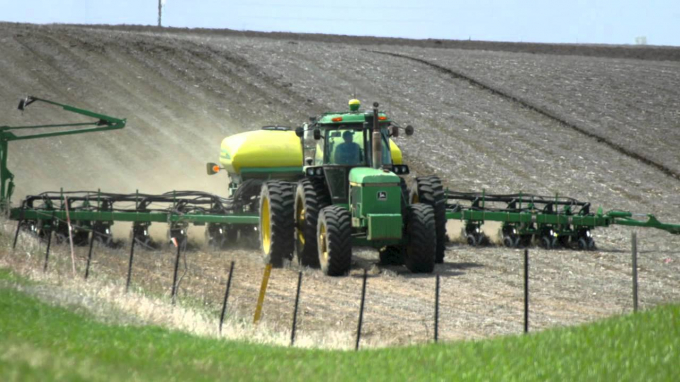May 29, 2025 | 16:07 GMT +7
May 29, 2025 | 16:07 GMT +7
Hotline: 0913.378.918
May 29, 2025 | 16:07 GMT +7
Hotline: 0913.378.918
Nearly all corn and about three-fourths of soybeans have emerged, according to the USDA Crop Progress Report.
CORN
As of Sunday, 90% of the corn had emerged, above an 82% five-year average

Corn planting in US.
In its report, the USDA pegged the U.S. corn good/excellent rating at 72%, below trade expectations of about 74%. This second good/excellent rating for the 2021 crop season is also below last week’s 76% good/excellent rating. It’s slightly below last year’s 75% rating at this point in the growing season.
SOYBEANS
As of Sunday, the USDA rated the nation’s soybean crop as 90% planted vs. a 79% five-year average; 76% has emerged, well ahead of the 59% five-year average.
USDA’s first 2021 condition estimate for soybean puts 67% of the crop in the good/excellent categories. That’s below last year’s rating of 72% good/excellent.
WHEAT
In its report Monday, the USDA rated the U.S. spring crop as 38% good/excellent vs. 43% a week ago.
The U.S. winter wheat crop is rated as 50% good/excellent, vs. 48% a week ago.
Crop progress and condition estimates are based on survey data collected each week from early April through the end of November, according to the USDA report. “The non-probability crop progress and condition surveys include input from approximately 3,600 respondents whose occupations provide them opportunities to make visual observations and frequently bring them in contact with farmers in their counties. Based on standard definitions, these respondents subjectively estimate the progress of crops through various stages of development, as well as the progress of producer activities. They also provide subjective evaluations of crop conditions,” the USDA stated in its Monday report.
Most respondents complete their questionnaires on Friday or early Monday morning and submit them to the National Agricultural Statistics Service (NASS) field offices in their states by mail, telephone, fax, email, or through a secured internet website. A small number of reports are completed on Thursday, Saturday, and Sunday. Regardless of when questionnaires are completed, respondents are asked to report for the entire week ending on Sunday, according to the report.
(Crop News)

(VAN) Vikas Rambal has quietly built a $5 billion business empire in manufacturing, property and solar, and catapulted onto the Rich List.

(VAN) Available cropland now at less than five percent, according to latest geospatial assessment from FAO and UNOSAT.

(VAN) Alt Carbon has raised $12 million in a seed round as it plans to scale its carbon dioxide removal work in the South Asian nation.

(VAN) Attempts to bring down the price of the Japanese staple have had little effect amid a cost-of-living crisis.

(VAN) Fourth most important food crop in peril as Latin America and Caribbean suffer from slow-onset climate disaster.

(VAN) Shifting market dynamics and the noise around new legislation has propelled Trouw Nutrition’s research around early life nutrition in poultry. Today, it continues to be a key area of research.

(VAN) India is concerned about its food security and the livelihoods of its farmers if more US food imports are allowed.